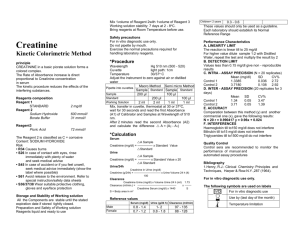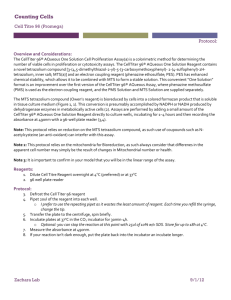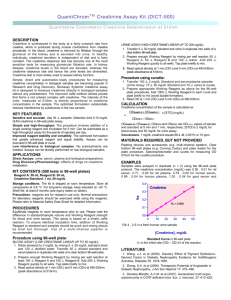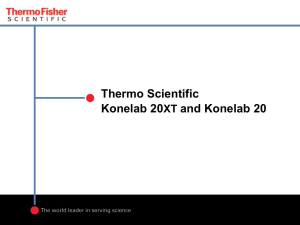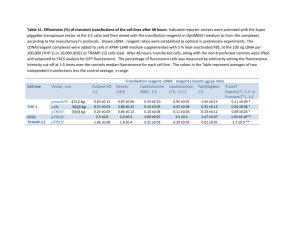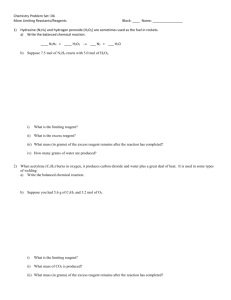File - AMHOP
advertisement
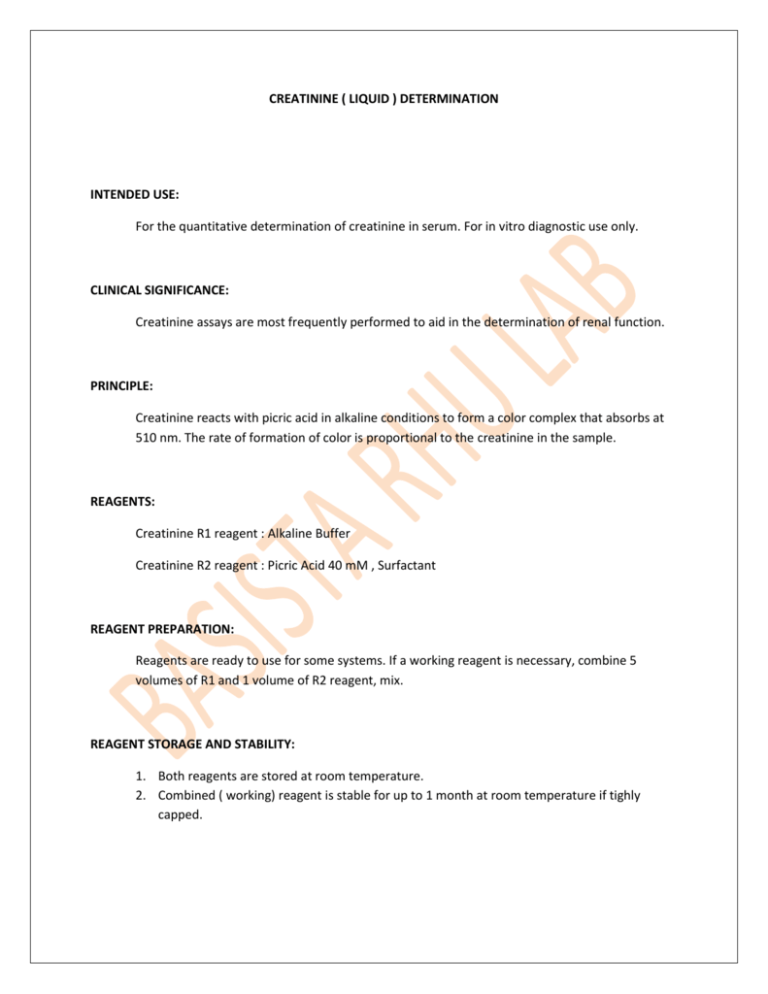
CREATININE ( LIQUID ) DETERMINATION INTENDED USE: For the quantitative determination of creatinine in serum. For in vitro diagnostic use only. CLINICAL SIGNIFICANCE: Creatinine assays are most frequently performed to aid in the determination of renal function. PRINCIPLE: Creatinine reacts with picric acid in alkaline conditions to form a color complex that absorbs at 510 nm. The rate of formation of color is proportional to the creatinine in the sample. REAGENTS: Creatinine R1 reagent : Alkaline Buffer Creatinine R2 reagent : Picric Acid 40 mM , Surfactant REAGENT PREPARATION: Reagents are ready to use for some systems. If a working reagent is necessary, combine 5 volumes of R1 and 1 volume of R2 reagent, mix. REAGENT STORAGE AND STABILITY: 1. Both reagents are stored at room temperature. 2. Combined ( working) reagent is stable for up to 1 month at room temperature if tighly capped. REAGENT DETERIORATION: Do not use if: 1. The reagent is cloudy ( contaminated) 2. The reagent falls to achieve assigned values on fresh control sera. PRECAUTIONS: 1. This reagent is for in vitro diagnostic use only. 2. Picric Acid is a strong oxidizing agent. Avoid contact with skin. Wipe any spillage, since evaporated picric acid is explosive. 3. All specimen and controls should be handled in accordance with good laboratory practices using appropriate precautions. SPECIMEN COLLECTION AND STORAGE: 1. Serum is recommended . 2. Creatinine in serum is stable for 24 hours at refrigerated temperatures ( 2-80C ) and for several months when frozen ( -200C ) and protected from evaporated and contamination. 3. 24 hour urine specimens must be preserved with 15 grams of boric acid. 4. All blood samples should be considered potentially infectious. INTERFERENCE: A number of substances affect the accuracy of creatinine. See Young , et al. MATERIALS: 1. 2. 3. 4. 5. 6. 7. Creatinine R1 reagent Creatinine R2 reagent Accurate pipetting devices Timer Test tube/ rack Spectrophotometer with a temperature controlled cuvette Heating block ( 370C ) PROCEDURE: 1. 2. 3. 4. 5. 6. 7. Prepare working reagent according to instructions. Set the spectrophotometer cuvette temperature to 370C . Pipette 1.0 ml of working reagent into each tube. Zero spectrophotometer with the reagent blank at 510 nm. Add .05 ml ( 50uL) of sample to reagent , mix and immediately place into cuvette. After exactly 60 seconds read and record the absorbance ( A1) At exactly 60 seconds after A1 reading , again read and record the absorbance ( A2), the time elapsed between A1 and A2 is 60 seconds. 8. Calculate the change in Absorbance ( Abs/min ) by subtracting ( A2- A1). See calculations. EXPECTED VALUES: 0.40 – 1.40 mg/dL LIMITATIONS: Sample with values above 25 m/dL should be diluted 1:1, re-assayed and results multiplied by 2. CALIBRATION: Use an NIST-traceable creatinine standard ( 2.5 mg/dL) or serum calibrator. The procedure should be calibrated according to the instrument manufacturer’s calibration instructions. If control results are found to be out of range, the procedure should be re-calibrated. CALCULATIONS: The creatinine value of the unknown is determined by comparing the absorbance change with that of a known standard. mg/dL = Abs ( unknown ) x concentration of Standard ( mg/dL ) Abs ( Standard ) Where : Abs. = Absorbance change between readings ( A2- A1) Sample Calculation: If Abs/ unknown = 0.02 Abs/ Standard = 0.05 Conc. Of Standard = 2.5 mg/dl Then: 0.02 x 2.5 = 1.0 mg/dL creatinine 0.05 QUALITY CONTROL: The integrity of the reaction should be monitored by use of normal and abnormal control sera with known creatinine values. These controls should be run at least with every working shift in which creatinine assays are performed. It is recommended that each laboratory establish their own frequency of control determination.
